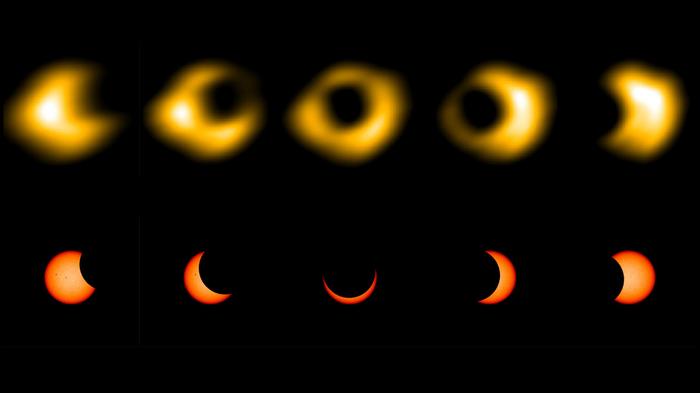Researchers at New Jersey Institute of Technology’s Center for Solar-Terrestrial Research (NJIT-CSTR) have captured the Oct. 14 solar eclipse in a way never seen before — recording the first radio images of an annular eclipse’s famous “ring of fire” effect.

Credit: Credit: Sijie Yu
Researchers at New Jersey Institute of Technology’s Center for Solar-Terrestrial Research (NJIT-CSTR) have captured the Oct. 14 solar eclipse in a way never seen before — recording the first radio images of an annular eclipse’s famous “ring of fire” effect.
The eclipse was partially visible to much of the continental U.S. for several hours that Saturday, though the full “ring of fire” effect was only visible for less than five minutes, and only for those within its 125-mile-wide path of annularity.
However, the new observations of the radio Sun’s eclipse — much longer in duration than the partial eclipse recently experienced by millions on Earth due to the extended solar corona as seen at radio wavelengths — have yielded stunning images of the eclipse’s ring lasting for over an hour.
Researchers used the newly commissioned Owens Valley Radio Observatory Long Wavelength Array (OVRO-LWA) in the Owens Valley Radio Observatory, CA to make their breakthrough observation of radio waves emanating from the Sun’s extended corona, as the moon passed between Earth and its nearest star.
“To finally see a ‘ring of fire’ eclipse this way was spectacular … we haven’t seen this quality of radio imaging of the Sun before.” said Dale Gary, NJIT-CSTR distinguished professor of physics and co-investigator on the OVRO-LWA project, which is funded by the National Science Foundation.
“We normally cannot see the corona from the ground except during a total eclipse, but we can now see it all the time with OVRO-LWA. This eclipse makes it that much more dramatic.”
“From our observatory site in California we were not in the belt to see the annular eclipse, yet we’ve been able to ‘see’ it all clearly unfold in radio, which reveals a much larger solar disk than its visible counterpart thanks to its sensitivity to the extended solar corona,” said Bin Chen, NJIT-CSTR associate professor of physics who led the data reduction and processing together with NJIT researchers Surajit Mondal and Sijie Yu.
“Science-wise, this is a unique opportunity to study the Sun’s extended corona with the highest resolution possible at these wavelengths, taking advantage of the moon’s limb as a moving ‘knife edge’ to increase the effective angular resolution,” said Chen.
OVRO-LWA, a multi-institutional project directed by Gregg Hallinan at California Institute of Technology, uses a set of 352 antennas to sample thousands of radio wavelengths between ~20-88 MHz.
For solar science, it offers the highest-quality images yet of the radio Sun in this wavelength regime, which is roughly two times larger than the visible solar disk.
“Documenting this spectacular event was a great opportunity to announce the successful operation of OVRO-LWA as a new radio facility to study the Sun and many other objects including exoplanets, cosmic-rays, the early universe, and more,” said Hallinan.
While the next annular solar eclipse is expected to be visible from South America in October 2024, those in the U.S. will need to wait until June 2039 to view the next ‘ring of fire’ eclipse on home soil. However, a total eclipse visible across the central U.S. will occur sooner, next April 8.
However, the team say the recent eclipse event is an outstanding example of the first observations of the Sun with the instrument. With the new capabilities OVRO-LWA offers, exciting science is expected in the near future — particularly as solar activity of the current 11-year solar cycle peaks in 2025 during the expected “solar maximum.”
“We are now working on an automated data processing pipeline that will soon produce near-real-time solar images and make them available to the public,” said Chen. “These eclipse images serve as a proof-of-concept for this effort. The unprecedented data products coming soon will open new opportunities for discovery in solar astronomy and space weather studies.”




